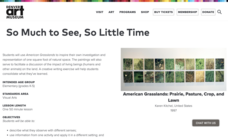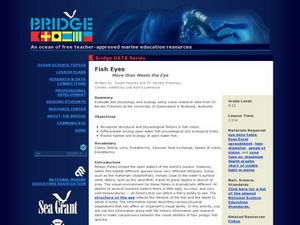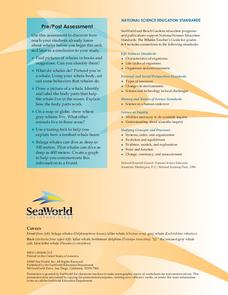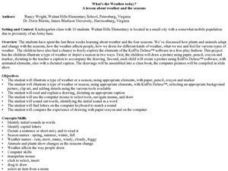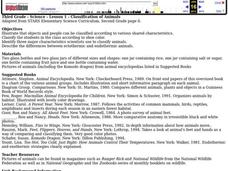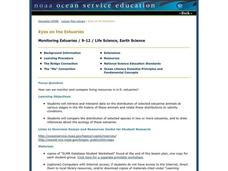American Museum of Natural History
What's This? Feeding
Some species have pretty creative methods for catching food. Young scientists learn about some interesting ways organisms get the nutrients they need by navigating an online interactive lesson that would be suitable for a remote learning...
Curated OER
Dogfighting Lesson Two - Bite Prevention and Community
Students discover how to prevent dog bites by completing worksheets and watching a video. In this animal safety lesson, students view a video called Dogs, Cats and Big Kids, taking notes throughout. Students take a quiz...
Curated OER
Triangles and Quadrilaterals
Second graders explore triangles and quadrilaterals. They rotate to various centers in the room to identify and examine triangles and quadrilaterals. After presenting a picture to the class, 2nd graders locate right angles, triangles...
Denver Art Museum
So Much to See, So Little Time
How do humans and animals impact the environment? What is land division? Youngsters tape off a 12x12 inch square in an outdoor natural space. They sketch everything they see, then compare their drawings as a class. They will then be...
Curated OER
Bite on This!
Different types of teeth have different roles. Third graders study how molars, incisors, and canines function in a rabbit skull and a cat skull. After answering some questions about the teeth of herbivores and carnivores, kids...
National Wildlife Federation
What's Your Habitat?
How are third graders like rabbits? They both live in habitats and require food, water, and shelter to survive! An educational science lesson encourages your learners to think about their own habitats and survival needs, before comparing...
Curated OER
Water Uses and Children's Lives in East Africa
Students explore water usage around the world. In this "water" social studies instructional activity, students brainstorm ways in which water is used. Students visit the Water in Africa website to view pictures of water usage...
Curated OER
Don't Call Me A Pig
First graders explore wildlife and habitats in the Arizona desert. Throughout a classroom discussion, 1st graders observe pictures of the desert and animals that live there. As they go on a nature walk around the school, students...
Curated OER
Introductory Bacteria and Virus Worksheet
Compare and contrast eukaryotes, prokaryotes, and viruses with a chart and a Venn diagram. Beginning microbiologists consider motility, reproductive ability, DNA content, and the presence of organelles. They write short answers to...
Chicago Botanic Garden
Plant Phenology Data Analysis
Scientists monitor seasonal changes in plants to better understand their responses to climate change, in turn allowing them to make predictions regarding the future. The last activity in the series of six has scholars analyze BudBurst...
Curated OER
Fish Eyes - More than Meets the Eye
Inform your class about the adaptations in fish eyes: cones, lens size, endothermy, and speed of vision. The adaptations are related to diving behavior. Junior marine scientists compare the adaptations of four different fish species to...
Ocean Explorer
Architects of the Coral Reef
Coral Reefs are the focus of a life science lesson plan. Upper graders look at how coral reefs are formed, how the animals and plants reproduce, and the variety of ways that humans benefit from coral reefs around the world. Groups of...
Sea World
Whales
A whale of a lesson is sure to intrigue your elementary oceanographers! Learn about the mammals of the sea with a series of activities about whales, dolphins, and porpoises. Kids complete worksheets about the anatomy of a whale, create a...
Curated OER
Cajun Critters Lesson Plan
Students identify animals of Louisiana. They compare and contrast animals. Students work in groups. They write descriptive paragraphs using proper grammatical structure. Students pick an animal within their groups, they research...
Curated OER
This Is Tree-rific!
Third graders view a clip of the video Backyard Safari, "Trees," and portray the life cycle of a tree. They also view a clip on structures of a tree and draw a diagram of a tree in their science journals.
Curated OER
Characteristics of Reptiles Lesson Plan
First graders draw pictures of reptiles and share them with the class describing the characteristics of the reptile. In this reptiles lesson plan, 1st graders determine if animals in pictures are reptiles or not.
Curated OER
The Mixed Up Chameleon
Students read the story The Mixed Up Chameleon and complete discussions questions as they read the story. For this comprehension lesson plan, students also draw animals, list animals, and create a class book.
Curated OER
Big Cat Classification
First graders discover the different names and classifications of big cats by using word processing applications. In this animal life lesson, 1st graders investigate one big cat and create a database of facts about it using an word...
Curated OER
Infusing Equity by Gender into the Classroom
Students discover the biases between the two genders by comparing males and females in different species. In this gender identity lesson, students research National Geographic Magazine and view videos demonstrating the differences...
Curated OER
Weather And The Seasons
Students illustrate characteristics of the different seasons using digital and pen and paper drawings. They creat captions for their drawings and present them to the class. Students compare and contrast their pen and paper drawing...
Curated OER
Fascinating Footprints
In this footprints instructional activity, students compare dinosaur prints and human prints. Students compare and draw different prints by answering 7 questions.
Curated OER
Using Venn Diagrams to Compare Two Ecosystems
Learners explore the distribution of two ecosystems on a global scale; and map the distribution of tropical and temperate rain forests throughout the world. They use a Venn Diagram to describe these ecosystems and the differences between...
Curated OER
Classification of Animals
Third graders practice classiyfying items and identify three major characteristics scientists use to classify animals. They describe the differences between ectothermic and endothermic animals.
Curated OER
Eyes on the Estuaries
Students study estuaries and compare several ones in the U.S. In this estuary instructional activity students interpret data and compare the distribution of different species.



